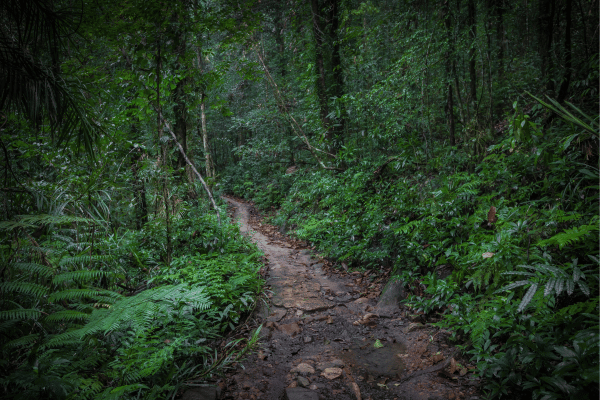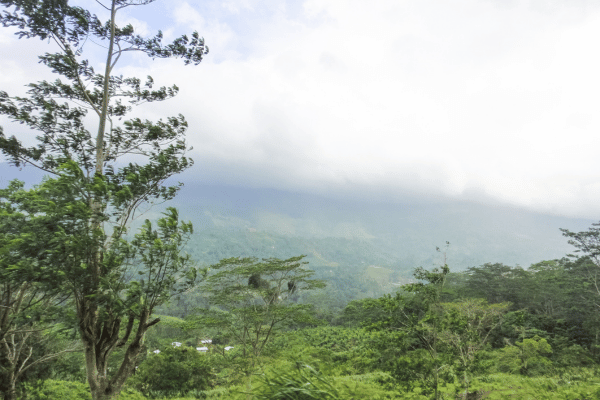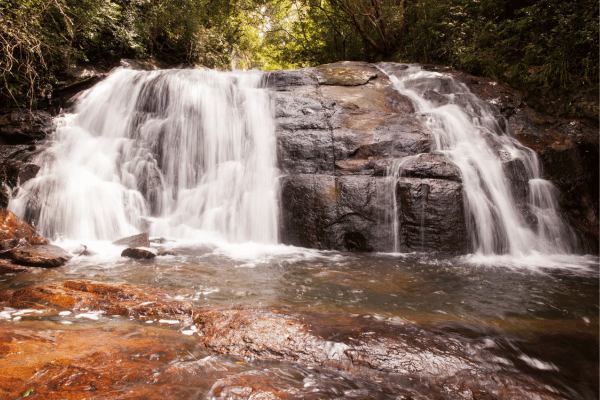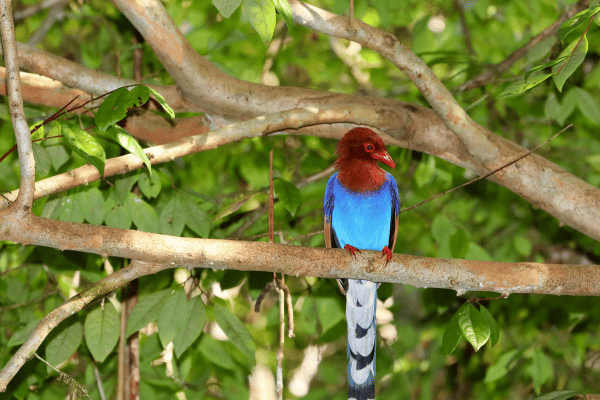A tropical rainforest located in Sri Lanka ‘ Sinharaja Rainforest ‘ – By Malsha – eLanka

Sinharaja Rainforest is a tropical rainforest located in southwestern Sri Lanka. It is one of the country’s most important natural landmarks and has been designated as a UNESCO World Heritage Site. The name “Sinharaja” translates to “Lion Kingdom” in Sinhalese, indicating its historical significance and its role as a protected habitat for wildlife.
Here are some key features and facts about Sinharaja Rainforest:
- Biodiversity: Sinharaja Rainforest is renowned for its exceptional biodiversity. It is home to a wide array of flora and fauna, including many endemic species found only in Sri Lanka. The forest is a haven for numerous birds, mammals, reptiles, amphibians, and insects.
- Flora: The rainforest is characterized by its dense vegetation, with towering trees reaching heights of over 40 meters (130 feet). It boasts over 240 species of trees, many of which are endemic. Sinharaja is known for its vibrant bird’s nest ferns, orchids, and lianas.
- Fauna: Sinharaja Rainforest supports an impressive diversity of animal species. It is home to various mammals, including leopards, purple-faced langurs, barking deer, and endemic species like the purple-faced leaf monkey and the Sri Lankan flying squirrel. The forest is also rich in birdlife, with over 160 species recorded, including the Sri Lanka blue magpie, Sri Lanka spurfowl, and green-billed coucal.
- Conservation Importance: Sinharaja Rainforest is considered a vital conservation area due to its significance in preserving Sri Lanka’s unique biodiversity. The forest acts as a watershed for several rivers and streams, providing a critical source of freshwater for surrounding communities.
- Trekking and Nature Trails: The rainforest offers several trekking and nature trails for visitors to explore its beauty and observe its wildlife. These trails vary in difficulty and length, providing options for different levels of hiking experience.
- Research and Education: Sinharaja Rainforest serves as a research site for scientists and conservationists studying tropical rainforest ecosystems. It is also a valuable educational resource, attracting students and researchers from around the world.
- Conservation Challenges: Despite its protected status, Sinharaja Rainforest faces various conservation challenges, including illegal logging, encroachment, and habitat fragmentation. Efforts are underway to mitigate these threats and preserve the integrity of the rainforest.
When visiting Sinharaja Rainforest, it is essential to respect the rules and regulations in place to protect its fragile ecosystem. Hiring a local guide is highly recommended to enhance your experience and ensure minimal impact on the environment.
Sinharaja Rainforest covers an area of approximately 11,187 hectares (27,600 acres) in southwestern Sri Lanka. It is relatively small compared to other rainforests around the world but is significant in terms of its biodiversity and ecological importance. The forest is elongated in shape, stretching about 21 kilometers (13 miles) from east to west and around 7 kilometers (4.3 miles) from north to south. Despite its relatively compact size, Sinharaja Rainforest is considered a crucial conservation area due to its rich biodiversity and endemic species.
Sinharaja Rainforest is located in the southwestern part of Sri Lanka, primarily within the Sabaragamuwa and Southern provinces. Here are some details about its geography:
- Location: The rainforest is situated in the central wet zone of Sri Lanka, covering parts of the Ratnapura, Kalutara, and Galle districts. It is nestled between the Napola Dola and Koskulana Ganga rivers.
- Elevation: Sinharaja Rainforest spans an elevation range of approximately 300 to 1,170 meters (984 to 3,839 feet) above sea level. The highest point within the rainforest is Mount Sinharaja, standing at an elevation of around 1,170 meters (3,839 feet).
- Topography: The rainforest features a rugged and undulating terrain. It consists of steep slopes, ridges, and valleys, creating a diverse microclimate within the forest.
- Hydrology: Sinharaja Rainforest is a significant watershed area. It serves as the origin of numerous streams and rivers, including the Gin Ganga, Kalu Ganga, and Nilwala Ganga, which provide essential water resources for the surrounding regions.
- Rainfall: The rainforest receives a high amount of rainfall, with an average annual precipitation ranging from 3,000 to 6,000 millimeters (118 to 236 inches). It experiences two distinct monsoon seasons: the southwest monsoon from May to September and the northeast monsoon from November to February.
- Connectivity: Sinharaja Rainforest is connected to the surrounding landscape through smaller forest patches, tea plantations, and human settlements. However, efforts are made to minimize habitat fragmentation and maintain the integrity of the rainforest ecosystem.
The geography of Sinharaja Rainforest contributes to its unique ecological characteristics, including its rich biodiversity and the formation of microhabitats that support a wide range of plant and animal species.

Why Sinharaja forest is famous?
Sinharaja Forest Reserve is famous for several reasons, making it a renowned natural landmark in Sri Lanka. Here are some key factors that contribute to its fame:
- Biodiversity Hotspot: Sinharaja Forest Reserve is recognized as a biodiversity hotspot and is considered one of the world’s most important rainforests. It is home to a remarkable variety of plant and animal species, many of which are endemic to Sri Lanka. The forest’s rich biodiversity and high endemism make it a significant ecological treasure.
- UNESCO World Heritage Site: Sinharaja Rainforest has been designated as a UNESCO World Heritage Site since 1988. This prestigious status highlights its universal value and the need for its protection and conservation.
- Endemic Species: The rainforest is known for its numerous endemic species, which are found nowhere else on Earth. Sinharaja is a habitat for several endemic bird species, such as the Sri Lanka blue magpie and Sri Lanka spurfowl, as well as endemic mammals like the purple-faced leaf monkey and the Sri Lankan flying squirrel. It also hosts a variety of endemic reptiles, amphibians, and plants.
- Conservation Importance: Sinharaja Rainforest plays a crucial role in conserving Sri Lanka’s unique biodiversity. Its protected status helps safeguard endangered species and preserve the integrity of the rainforest ecosystem. Conservation efforts in Sinharaja are seen as vital for maintaining the ecological balance of the region.
- Research and Education: The rainforest provides an excellent site for scientific research and education. It attracts scientists, researchers, and students from around the world who study its flora, fauna, and ecosystem dynamics. The research conducted in Sinharaja contributes to broader knowledge about tropical rainforests and aids in conservation efforts globally.
- Nature Tourism: Sinharaja Forest Reserve is a popular destination for nature enthusiasts and eco-tourists. Visitors can explore its lush greenery, trek along nature trails, and experience the unique sights and sounds of a tropical rainforest. The forest’s beauty and the opportunity to observe rare wildlife make it a sought-after attraction for nature lovers.
Due to its exceptional biodiversity, UNESCO recognition, and conservation significance, Sinharaja Rainforest has gained international fame as a remarkable natural heritage site. It offers a glimpse into the wonders of a pristine tropical rainforest and the importance of preserving such ecosystems for future generations.

While Sinharaja Rainforest is not primarily known for its waterfalls, there are a few waterfalls located in or near the vicinity of the forest. Here are a couple of notable waterfalls you can find in the Sinharaja area:
- Donugama Ella: Donugama Ella is a picturesque waterfall located near Sinharaja Rainforest in the Ratnapura District. It is approximately 30 meters (98 feet) in height and cascades down a rocky cliff. The waterfall is surrounded by lush greenery, creating a serene and beautiful setting.
- Neluwa Duwili Ella: Neluwa Duwili Ella is another waterfall close to Sinharaja Rainforest, situated in the Neluwa area of Galle District. It is a multi-tiered waterfall that plunges down in stages, with the highest tier measuring around 30 meters (98 feet) in height. The surrounding forest and the soothing sound of cascading water make it a tranquil spot to visit.
While these two waterfalls are within reasonable proximity to Sinharaja Rainforest, they are not located within the forest itself. Sinharaja is primarily renowned for its rich biodiversity, pristine rainforest environment, and unique flora and fauna. However, exploring the nearby waterfalls can add to your overall experience of the area and provide opportunities to enjoy the natural beauty of the region.

Sinharaja Forest Reserve is teeming with a diverse range of animals and birds. The rainforest’s rich biodiversity and protected status have made it a haven for numerous species, including many endemic and endangered ones. Here are some notable animals and birds found in Sinharaja Forest:
Animals:
- Purple-faced Langur: Also known as the purple-faced leaf monkey, this endangered primate is endemic to Sri Lanka and can be found swinging through the trees of Sinharaja Forest.
- Sri Lankan Leopard: The elusive Sri Lankan leopard inhabits the forest, although sightings are rare due to their stealthy nature. They are the top predators in the area.
- Fishing Cat: Sinharaja is home to the fishing cat, a medium-sized wildcat known for its adeptness at catching fish. It is classified as vulnerable and has a distinctive appearance with a stocky build and webbed feet.
- Sri Lankan Flying Snake: This unique snake species found in Sinharaja has the remarkable ability to glide through the air, using its flattened body and extended ribs to glide between trees.
- Hump-nosed Lizard: The hump-nosed lizard is a fascinating reptile species endemic to Sri Lanka. Its distinctive feature is the upward-pointing, hump-like projection on its nose.
Birds:

- Sri Lanka Blue Magpie: The Sri Lanka blue magpie is a stunning bird with a vibrant blue plumage and a long, sweeping tail. It is endemic to Sri Lanka and can be spotted in the forest.
- Sri Lanka Spurfowl: This endemic bird is known for its striking appearance, featuring a red facial patch and a distinct call. Sinharaja is one of its key habitats.
- Sri Lanka Frogmouth: The Sri Lanka frogmouth is a nocturnal bird species with excellent camouflage. It is known for its large, wide beak and a characteristic posture that resembles a tree branch.
- Green-billed Coucal: This endemic bird species has a unique and vibrant appearance, with green plumage and a long, downward-curving bill. Sinharaja provides a suitable habitat for its survival.
- Sri Lanka Hanging Parrot: As its name suggests, this small parrot species is known for its ability to hang upside down while feeding. It is endemic to Sri Lanka and can be found in Sinharaja Forest.
These are just a few examples of the diverse array of animals and birds you may encounter while exploring Sinharaja Forest. The rainforest’s status as a UNESCO World Heritage Site underscores its importance as a habitat for unique and threatened species, making it a prime destination for wildlife enthusiasts and birdwatchers.
While Sinharaja faces conservation challenges such as illegal logging and habitat fragmentation, efforts are being made to protect and preserve its integrity. By respecting its rules and regulations and supporting conservation initiatives, we can help safeguard this remarkable rainforest for future generations to appreciate and cherish.







